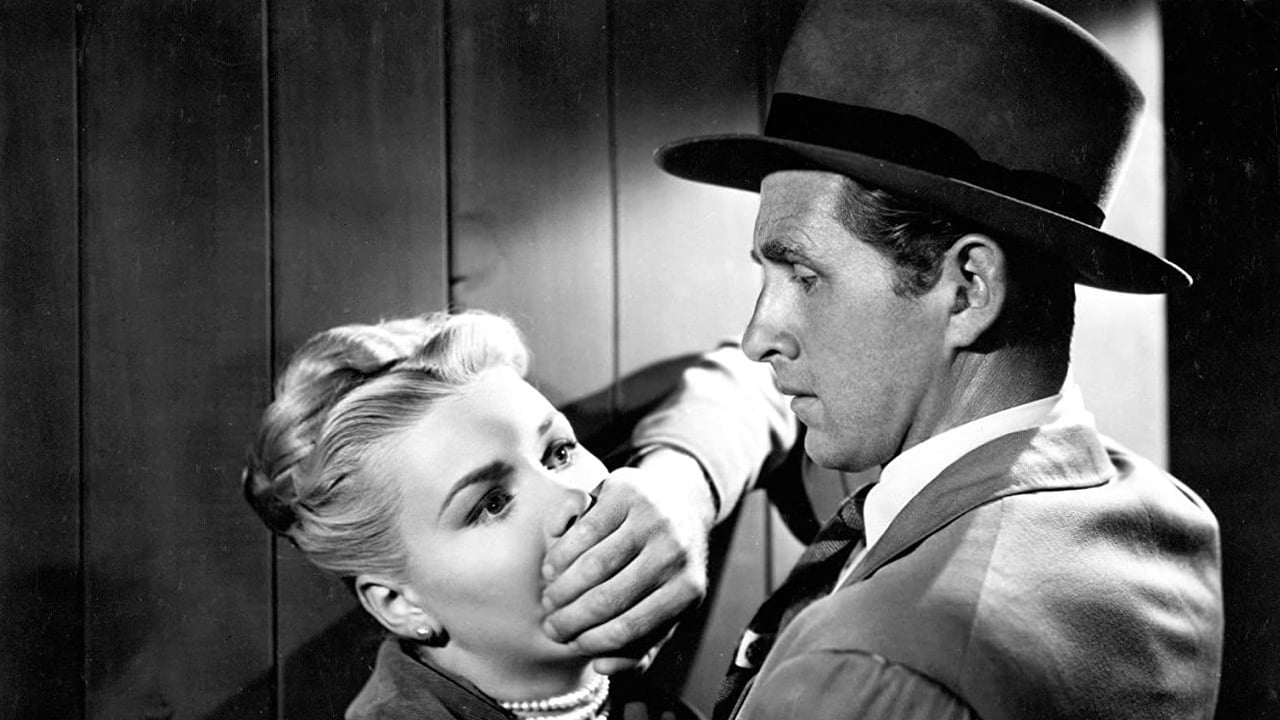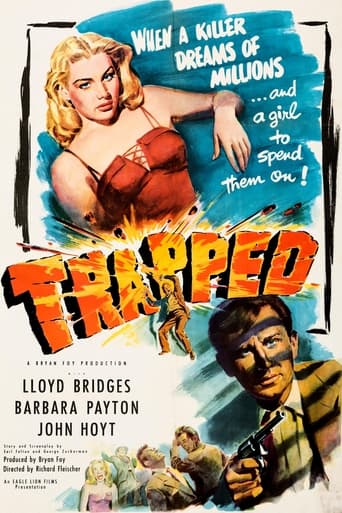

"Trapped" has the darkness of both cinematography and spirit that distinguishes film noir. A story of thieves and counterfeiters and undercover cops, it grabs attention and holds it until the surprising and violent end. The script is tight and believable. One of the best things the film has going for it is that it was the first large role for the very talented but tragically doomed Barbara Payton. In "Trapped" she is the girlfriend of counterfeiter/thief Tris Stewart. The character Payton plays is Meg Dixon who calls herself Laurie Fredericks. Unlike the typical film noir femme fatale, the strikingly beautiful blonde is not so much nasty and cold-blooded as foolishly devoted to her criminal boyfriend. She adopts a criminal lifestyle out of love for him. Played by the handsome Lloyd Bridges, Tris Stewart is an utterly amoral psychopath motivated by sheer greed along with his own love for Meg/Laurie. Perhaps the only weak link in the film is John Hoyt as undercover cop John Downey. We should sympathize with Downey as the chief representative of the law but Hoyt's character appears so cold and calculating that he does not seem much better than the crooks he is trying to catch. However, this is a minor flaw in a fine film.
... View MoreThis neat little thriller was directed by Richard Fleischer at the beginning of his "noir" period. He got better at it after this one--the terrific "Narrow Margin" and "Armored Car Robbery"--but this is still a good one, if a bit too slow at times.Lloyd Bridges is a convicted counterfeiter serving time when he cuts a deal with the Treasury Department. It seems that when he was nabbed, his partner kept the plates and now almost flawless counterfeit currency is flooding Los Angeles. The feds believe it's Bridges' partner, and they'll cut his sentence in exchange for letting him out to find his partner and retrieve the plates. Once he gets out, however, he double-crosses them and plans to get the plates himself. As it turns out, Bridges isn't quite as slick as he thinks he is, and things start to go south rather quickly. Although not quite as fast-paced as Fleischer's better-known thrillers, it benefits tremendously from Bridges' presence. He's very tightly wound in this one, and quite a bit more brutal than you would expect him to be, even playing a bad guy. Tragic figure Barbara Payton actually does quite well as his floozy girlfriend, and the sinister John Hoyt does an excellent job as a somewhat enigmatic character who turns out to be not quite what he seems.Good atmosphere and some neat plot--and other--twists make this a good companion piece to Fleischer's later noirs, and definitely worth a watch.
... View MoreThe film begins with a rather heavy-handed and hokey introduction extolling the virtues of Secret Service in their dealing with forged American dollars. Then, the actual story begins. It seems that a counterfeit $20 has turned up--and it's an awful lot like one passed by a man who has now been in prison several years (Lloyd Bridges). When he's questioned, he refuses to cooperate. However, when he does seem to be cooperating, it's a ruse--and soon he's escaped from custody. Eventually he makes his way back to his old gang--and he wants in for some of the action. Along the way, he meets up with a sharp character (John Hoyt) who wants to bankroll Bridges' scheme to make a killing with counterfeit bills. How all this works out is something you should see for yourself--and I really don't want to spoil the suspense by saying more.When this fame debuted in 1949, Bridges and Hoyt were hardly household names. Bridges went on to great fame in the 1950s and 60s but here he plays a guy very much unlike his later roles--in "Trapped", he's just a nasty little hood. As for Hoyt, he's a face many will recognize though his name would escape most. He generally played cranky guys who were not the least bit macho or heroic, yet here he plays a man definitely against this type! In fact, it might just be one of Hoyt's best roles--if not his best. It's a shame, really, as he MIGHT have become a household name, as he was the original Doctor in the pilot episode of "Star Trek".Overall, the film has a dandy script, is very entertaining and is a nice example of a lesser film noir movie that deserves to be seen. While not great, it certainly is very good and quite watchable.
... View MoreThe opening of the film is a prolonged ode to the US Treasury in all its offices but particularly its role in the issuing of bank notes and prevention of counterfeit dosh. Then off we go with our hero released from jail (for counterfeiting) so he can help find who is now using his marvellous plates. This is no great noir but it is interesting enough and has its moments on the streets of LA. The finale in a tram shed containing LA electric street cars is effective and there are other set pieces making this worth a view. Bridges is most effective and Barbara Payton does well as the good looking moll. Predictable in parts but the action switches enough to maintain attention.
... View More